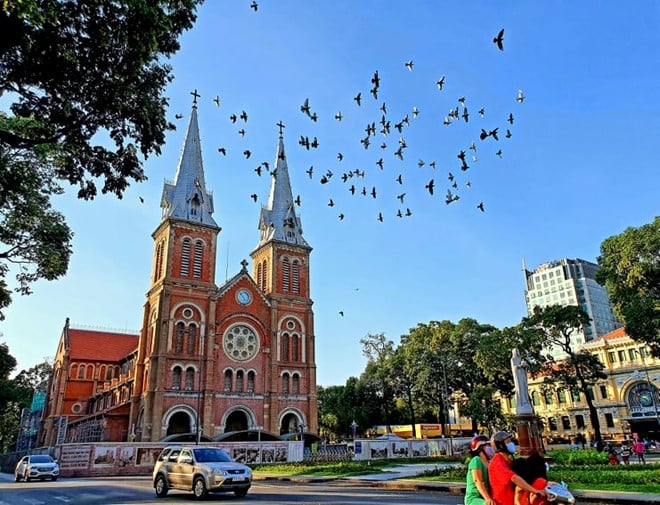

Ho Chi Minh City, formerly named Saigon is the second largest city in Vietnam. Under the name Saigon, it was the capital of the French colony of Cochin-china and later of the independent state of South Vietnam from 1955 to 1975. In 1976, Saigon merged with the surrounding Gia Dinh Province and was officially renamed Ho chi Minh city.

Notre-Dame Cathedral
The city center is situated on the banks of the Saigon River, 60 kilometers from the South China Sea and 1,760 kilometers south of Hanoi, the capital of Vietnam.
The population of Ho Chi Minh City, as of the 2024 Census, was 9,568,000, about 8.7% of the total population of Vietnam, making it the highest population-concentrated city in the country. As the largest economic and financial hub of Vietnam, HCMC has attracted more and more immigrants from other Vietnamese provinces in recent years; consequently its population has been and still is growing rapidly. The majority of the population is ethnic Vietnamese at about 93.52%. Ho Chi Minh City's largest minority ethnic group is the Chinese with 5.78%. Cholon – in District 5 and parts of Districts 6, 10 and 11 – is home to the largest Chinese community in Vietnam. Other ethnic minorities include Khmer 0.34%, Cham 0.1%.
Ho Chi Minh City is the economic center of Vietnam and accounts for a large proportion of the economy of Vietnam, contributes around 23% of the country’s GDP. The consumption demand of Ho Chi Minh City is much higher than other provinces and municipalities of Vietnam and 1.6 times higher than that of Hanoi. The economy of Ho Chi Minh City consists of industries ranging from mining, seafood processing, agriculture, and construction, to tourism, finance, industry and trade.
There are 171 medium and large-scale markets as well as several supermarket chains, shopping malls, and fashion and beauty centers. Some of the larger shopping malls and plazas opened recently.
Tan Son Nhat Airport is currently the largest airport in Vietnam in terms of passengers handled. Ho Chi Minh City is also a terminal for many Vietnam Railways train routes in the country. The Reunification Express runs from Ho Chi Minh City to Hanoi from Saigon Railway Station in District 3, with stops at cities and provinces along the line. The city's location on the Saigon River makes it a bustling commercial and passenger port; besides a constant stream of cargo ships, passenger boats operate regularly between Ho Chi Minh City and various destinations in Southern Vietnam and Cambodia, including Vung Tau, Can Tho and the Mekong Delta, and Phnom Penh. Traffic between Ho Chi Minh City and Vietnam's southern provinces has steadily increased over the years.

Landmark 81 Tower in HCMC
The main means of transport within the city are motorbikes, buses, taxis, and bicycles. Motorbikes remain the most common way to move around the city. Taxis are plentiful and usually have trip meters, although it is also common to agree on the trip price before taking a long trip. Public buses run on many routes and fare can be purchased on the bus. For short trips, "xe om" - motorcycle taxis are available where the passenger sits at the rear of a motorbike. A popular activity for tourists is a tour of the city on cyclos, which allow for longer trips at a more relaxed pace.
Today, the city's core is still adorned with wide elegant boulevards and historic French colonial buildings. The most prominent structures in the city center are Reunification Palace, City Hall, the Municipal Theatre, also known as the Opera House, City Post Office, State Bank Office, City People's Court and Notre-Dame Cathedral. Some of the historic hotels are the Hotel Majestic, dating from the French colonial era, and the Rex Hotel, Caravelle hotel some former hangouts for American officers and war correspondents in the 1960s and 1970s..
The city has various museums, such as the Ho Chi Minh City Museum, Museum of Vietnamese History, the Revolutionary Museum, the Museum of Southeastern Armed Forces, the War Remnants Museum, the Museum of Southern Women, the Museum of Fine Art, the Nha Rong Memorial House, and the Ben Duoc Relic of Underground Tunnels. The Cu Chi tunnels are northwest of the city in Cu Chi district, The Saigon Zoo and Botanical Gardens, in District 1, dates from 1865.
Like many of Vietnam's smaller cities, the city boasts a multitude of restaurants serving typical Vietnamese dishes such as Pho or rice vermicelli. Backpacking travelers most often frequent the "Western Quarter" on Pham Ngu Lao Street in District 1.
Traveling in Saigon – Ho Chi Minh city is simply a great experience. Here, there are many things are waiting for you to see, taste and enjoy.
***
Travel Authentic Asia Company is your best choice for discovering the beauty of Southeast Asia. Our experienced and knowledgeable travel advisors are committed to helping you create a tailor-made tour and extraordinary experiences in this majestic region.
If you're looking for an authentic cultural experience, do not hesitate to contact Travel Authentic Asia to choose a Vietnam tour, Southeast Asia tour package or to customize your own style tour to South East Asia.